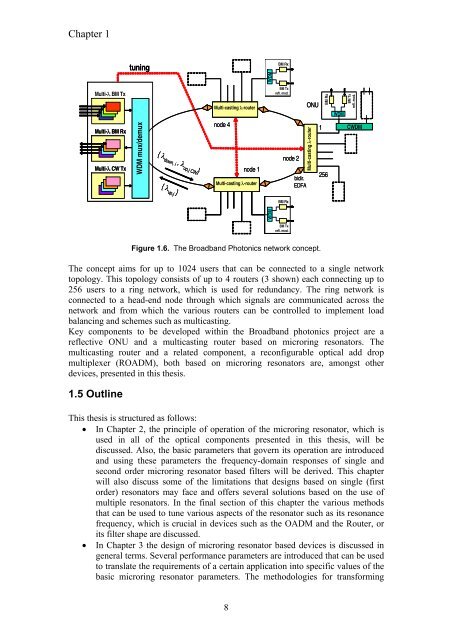Edwin Jan Klein - Universiteit Twente
Edwin Jan Klein - Universiteit Twente
Edwin Jan Klein - Universiteit Twente
You also want an ePaper? Increase the reach of your titles
YUMPU automatically turns print PDFs into web optimized ePapers that Google loves.
Chapter 1<br />
Multi-λ BM Tx<br />
Multi-λ BM Rx<br />
Multi-λ CW Tx<br />
The concept aims for up to 1024 users that can be connected to a single network<br />
topology. This topology consists of up to 4 routers (3 shown) each connecting up to<br />
256 users to a ring network, which is used for redundancy. The ring network is<br />
connected to a head-end node through which signals are communicated across the<br />
network and from which the various routers can be controlled to implement load<br />
balancing and schemes such as multicasting.<br />
Key components to be developed within the Broadband photonics project are a<br />
reflective ONU and a multicasting router based on microring resonators. The<br />
multicasting router and a related component, a reconfigurable optical add drop<br />
multiplexer (ROADM), both based on microring resonators are, amongst other<br />
devices, presented in this thesis.<br />
1.5 Outline<br />
tuning<br />
WDM mux/demux<br />
{ { λλ down, down, i i , , λλ up,j up,j CW} CW}<br />
{ { λλ up,j up,j } }<br />
Multi-casting λ-router<br />
node 4<br />
Multi-casting λ-router<br />
This thesis is structured as follows:<br />
• In Chapter 2, the principle of operation of the microring resonator, which is<br />
used in all of the optical components presented in this thesis, will be<br />
discussed. Also, the basic parameters that govern its operation are introduced<br />
and using these parameters the frequency-domain responses of single and<br />
second order microring resonator based filters will be derived. This chapter<br />
will also discuss some of the limitations that designs based on single (first<br />
order) resonators may face and offers several solutions based on the use of<br />
multiple resonators. In the final section of this chapter the various methods<br />
that can be used to tune various aspects of the resonator such as its resonance<br />
frequency, which is crucial in devices such as the OADM and the Router, or<br />
its filter shape are discussed.<br />
• In Chapter 3 the design of microring resonator based devices is discussed in<br />
general terms. Several performance parameters are introduced that can be used<br />
to translate the requirements of a certain application into specific values of the<br />
basic microring resonator parameters. The methodologies for transforming<br />
8<br />
node 1<br />
WDM<br />
WDM<br />
BM Rx<br />
BM Tx<br />
refl. mod.<br />
node 2<br />
BM Rx<br />
BM Tx<br />
refl. mod.<br />
Multi-casting λ-router<br />
bidir.<br />
EDFA<br />
ONU<br />
Figure 1.6. The Broadband Photonics network concept.<br />
1<br />
BM Rx<br />
256<br />
WDM<br />
BM Tx<br />
refl. mod.<br />
CWDM















